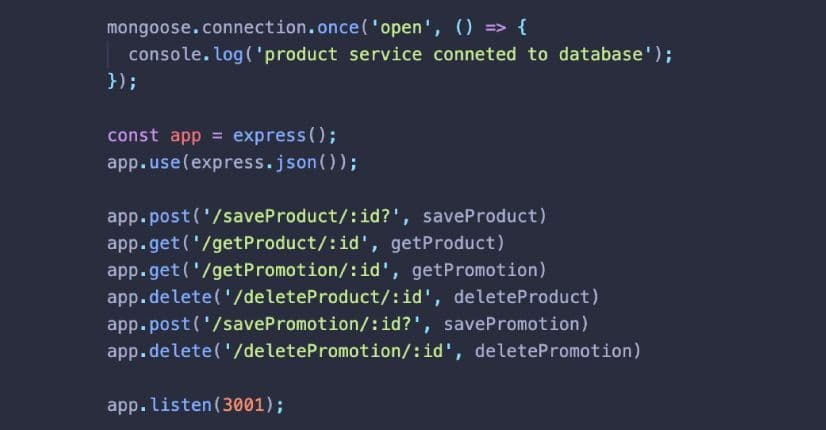tech stack
software development
+ 4 more ...
An Introduction to MERN: NodeJS
08 Jul 2021
by Dániel & Lotte
08 Jul 2021
by Dániel & Lotte
tech stack
software development
app development
nodejs
javascript
MERN
An Introduction to MERN: NodeJS
Table of contents
Contact us
We will get back to you in the next 48 hours.

NodeJS forms an integral part of the MERN tech stack, providing a highly scalable and agile solution for app development experts.
As an entrepreneur who is looking for a digital partner for the development of their very own application, it can be difficult to follow the technical jargon that’s mentioned in many consultancy meetings and proposals. If you’re not a software developer yourself, the information regarding technical specifications can be complex and difficult to understand. As a company of digital experts, we want to make sure our clients are always on the same page as us, no matter how complex the topic. That’s why we have been taking a deep dive into the technologies and frameworks our development team at Lizard Global works with on a daily basis. This week, we’re having a look at our MERN tech stack, and the programming language NodeJS in particular.
The tech stack of MERN
MERN is a full-stack web development framework made up of four important Javascript technologies: MongoDB, ExpressJS, ReactJS, and NodeJS. All layers of application development are covered by these four technologies. At Lizard Global, we use ReactJS for the UI (frontend), ExpressJS and NodeJS for the server and MongoDB for databases. Since these technologies are carefully picked to work together seamlessly, the MERN tech stack allows us to build high-quality applications in an efficient and agile manner, while accommodating fast-changing requirements.

Reading an object from database and sending it to the browser (Node & MongoDB)
MERN has a large supporting community. It’s usually easy to find a solution for various problems that appear during the development process and documentation is widely available. It also has a low learning curve, which means that developers don’t have to spend months studying the languages and frameworks before being able to start working with them. Another important point to mention is that all these technologies are open source and free, which reduces the complexity of licensing.
Introducing NodeJS
NodeJS is a programming language, a modified version of Javascript that can be run outside the user’s browser, typically on the server. It’s extended with some modules to be able to interact with the server such as reading the file system or sending HTTP responses. It’s relatively new, compared to other popular programming languages, as it was released in 2009.
NodeJS is an asynchronous language, which means that it can do more than one thing at the same time. For example, the language can fetch a network request and work on other tasks simultaneously while waiting for the response. NodeJS also implements the revolutionary concept of so-called “two-way web communication”. While classically only the browser could request information from the server, now the server can also notify the browser, allowing it to be used to build real-time applications.
NodeJS in MERN
As mentioned above, NodeJS forms an indispensable part of the MERN tech stack. This means that the language closely interacts and collaborates with the other languages and frameworks in that particular stack. Most importantly, NodeJS shares data with the other MERN elements in a unified format using JSON (Javascript Object Notation). It’s a data model that is easy to work with and is natively understood by all the frameworks and languages in the MERN stack. MongoDB is also using this format to store and send data from the database. All these technologies are tightly connected - ReactJS is a framework built on Javascript, a specific implementation of Javascript, so to speak. NodeJS is also built on Javascript. ExpressJS, which is basically a middleman between the server and the browser, is built on NodeJS. They’re all connected and working together, carefully and strategically stacked on top of each other, hence the term “tech-stack”.

Defining backend routes on the server (Express & Node)
NodeJS and Javascript
NodeJS and Javascript can be seen as roughly the same language. The key difference is the fact that Javascript is mostly aimed at working in browsers. Javascript is what makes a website interactive: it can handle logic, but can also directly modify the DOM (Document Object Model), which is the structure and look of the website. At Lizard Global, we use it to request and handle data coming from the server, then dynamically render a certain user interface based on that. A modern website is unimaginable without using Javascript. Although it’s been around for a long time, it’s still being improved and extended from time to time to keep up with the rest of the industry and rapidly advancing technologies. With new ways being invented to use Javascript (like nodeJS or React), websites nowadays are more reliant on it than ever.
Node Package Manager
We can’t talk about NodeJS without mentioning NPM - node package manager. It’s the world's largest software registry and also happens to be open-source. It lets us easily install and integrate modules to our application that was already developed and published by other developers, saving incredible amounts of development time. For example, if you need a tool to handle and format dates, you don’t have to write it from scratch. Instead, you can find an NPM module for this purpose and build on that. ReactJS and ExpressJS are also integrated into our software via NPM.

Importing open-source NPM packages to the software (NodeJS)
Using NodeJS at Lizard Global
Our full-stack development team at Lizard Global is always trying to get the best out of what each technology has to offer and use them in a way that is the most appropriate and efficient for the end goal. We reuse components that can be reused to save time, and where needed, we build our own for the custom needs of each solution. One of the primary goals is to unify our technology stack and use a single language, Javascript, for everything. This makes development and maintenance much smoother and it’s easier to share work among developers. It also eliminates the need of having to learn another specialised language, so we focus on delivering quality work instead. If you know Javascript - you pretty much know NodeJS too.
All in all, NodeJS offers numerous benefits. Let’s have a look at the most notable advantages:
- Highly scalable and suitable to build big applications without losing quality
- Flexible to efficiently accommodate changes, great for MVP development
- Fast and agile
- High-performance
- Low learning curve (easy to learn)
- Large online community and access to helpful information
Need a hand?
Want to know more about our tech stack at Lizard Global and how we make sure your solution is always following the latest advancements in technology? Get in touch with our experts! Are you still looking for a digital partner for the technical development of your very own application? We’d love to hear more about your innovative ideas, so give us a call and let’s schedule a meeting!

NodeJS forms an integral part of the MERN tech stack, providing a highly scalable and agile solution for app development experts.
As an entrepreneur who is looking for a digital partner for the development of their very own application, it can be difficult to follow the technical jargon that’s mentioned in many consultancy meetings and proposals. If you’re not a software developer yourself, the information regarding technical specifications can be complex and difficult to understand. As a company of digital experts, we want to make sure our clients are always on the same page as us, no matter how complex the topic. That’s why we have been taking a deep dive into the technologies and frameworks our development team at Lizard Global works with on a daily basis. This week, we’re having a look at our MERN tech stack, and the programming language NodeJS in particular.
The tech stack of MERN
MERN is a full-stack web development framework made up of four important Javascript technologies: MongoDB, ExpressJS, ReactJS, and NodeJS. All layers of application development are covered by these four technologies. At Lizard Global, we use ReactJS for the UI (frontend), ExpressJS and NodeJS for the server and MongoDB for databases. Since these technologies are carefully picked to work together seamlessly, the MERN tech stack allows us to build high-quality applications in an efficient and agile manner, while accommodating fast-changing requirements.

Reading an object from database and sending it to the browser (Node & MongoDB)
MERN has a large supporting community. It’s usually easy to find a solution for various problems that appear during the development process and documentation is widely available. It also has a low learning curve, which means that developers don’t have to spend months studying the languages and frameworks before being able to start working with them. Another important point to mention is that all these technologies are open source and free, which reduces the complexity of licensing.
Introducing NodeJS
NodeJS is a programming language, a modified version of Javascript that can be run outside the user’s browser, typically on the server. It’s extended with some modules to be able to interact with the server such as reading the file system or sending HTTP responses. It’s relatively new, compared to other popular programming languages, as it was released in 2009.
NodeJS is an asynchronous language, which means that it can do more than one thing at the same time. For example, the language can fetch a network request and work on other tasks simultaneously while waiting for the response. NodeJS also implements the revolutionary concept of so-called “two-way web communication”. While classically only the browser could request information from the server, now the server can also notify the browser, allowing it to be used to build real-time applications.
NodeJS in MERN
As mentioned above, NodeJS forms an indispensable part of the MERN tech stack. This means that the language closely interacts and collaborates with the other languages and frameworks in that particular stack. Most importantly, NodeJS shares data with the other MERN elements in a unified format using JSON (Javascript Object Notation). It’s a data model that is easy to work with and is natively understood by all the frameworks and languages in the MERN stack. MongoDB is also using this format to store and send data from the database. All these technologies are tightly connected - ReactJS is a framework built on Javascript, a specific implementation of Javascript, so to speak. NodeJS is also built on Javascript. ExpressJS, which is basically a middleman between the server and the browser, is built on NodeJS. They’re all connected and working together, carefully and strategically stacked on top of each other, hence the term “tech-stack”.

Defining backend routes on the server (Express & Node)
NodeJS and Javascript
NodeJS and Javascript can be seen as roughly the same language. The key difference is the fact that Javascript is mostly aimed at working in browsers. Javascript is what makes a website interactive: it can handle logic, but can also directly modify the DOM (Document Object Model), which is the structure and look of the website. At Lizard Global, we use it to request and handle data coming from the server, then dynamically render a certain user interface based on that. A modern website is unimaginable without using Javascript. Although it’s been around for a long time, it’s still being improved and extended from time to time to keep up with the rest of the industry and rapidly advancing technologies. With new ways being invented to use Javascript (like nodeJS or React), websites nowadays are more reliant on it than ever.
Node Package Manager
We can’t talk about NodeJS without mentioning NPM - node package manager. It’s the world's largest software registry and also happens to be open-source. It lets us easily install and integrate modules to our application that was already developed and published by other developers, saving incredible amounts of development time. For example, if you need a tool to handle and format dates, you don’t have to write it from scratch. Instead, you can find an NPM module for this purpose and build on that. ReactJS and ExpressJS are also integrated into our software via NPM.

Importing open-source NPM packages to the software (NodeJS)
Using NodeJS at Lizard Global
Our full-stack development team at Lizard Global is always trying to get the best out of what each technology has to offer and use them in a way that is the most appropriate and efficient for the end goal. We reuse components that can be reused to save time, and where needed, we build our own for the custom needs of each solution. One of the primary goals is to unify our technology stack and use a single language, Javascript, for everything. This makes development and maintenance much smoother and it’s easier to share work among developers. It also eliminates the need of having to learn another specialised language, so we focus on delivering quality work instead. If you know Javascript - you pretty much know NodeJS too.
All in all, NodeJS offers numerous benefits. Let’s have a look at the most notable advantages:
- Highly scalable and suitable to build big applications without losing quality
- Flexible to efficiently accommodate changes, great for MVP development
- Fast and agile
- High-performance
- Low learning curve (easy to learn)
- Large online community and access to helpful information
Need a hand?
Want to know more about our tech stack at Lizard Global and how we make sure your solution is always following the latest advancements in technology? Get in touch with our experts! Are you still looking for a digital partner for the technical development of your very own application? We’d love to hear more about your innovative ideas, so give us a call and let’s schedule a meeting!
FAQs

What is MERN?
What is NodeJS?
What is Javascript?
What are the advantages of NodeJS?







